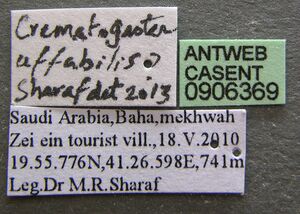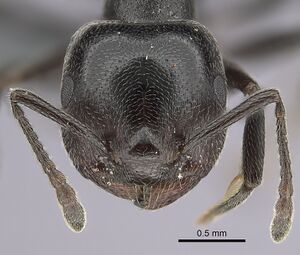Crematogaster chiarinii
| Crematogaster chiarinii | |
|---|---|

| |
| Scientific classification | |
| Kingdom: | Animalia |
| Phylum: | Arthropoda |
| Class: | Insecta |
| Order: | Hymenoptera |
| Family: | Formicidae |
| Subfamily: | Myrmicinae |
| Tribe: | Crematogastrini |
| Genus: | Crematogaster |
| Species: | C. chiarinii |
| Binomial name | |
| Crematogaster chiarinii Emery, 1881 | |
| Subspecies | |
| |
| Synonyms | |
| |
This arboreal, long spined, black ant is common in southern Arabia wherever there are trees (Collingwood and Agosti 1996).
Identification
Keys including this Species
Distribution
Sharaf et al. (2019): This species was originally described from Ethiopia and is widely distributed in the Afrotropical region. It seems to be a predominantly eastern African species but is also known from Central and South Africa (Guénard et al. 2017; Janicki et al. 2017). From the Arabian Peninsula, the species has been recorded from the southwestern mountains of the KSA and Oman (Wheeler 1922; Borowiec 2014; Collingwood 1985, Collingwood and Agosti 1996).
Latitudinal Distribution Pattern
Latitudinal Range: 21.7575° to 2.333333333°.
| North Temperate |
North Subtropical |
Tropical | South Subtropical |
South Temperate |
- Source: AntMaps
Distribution based on Regional Taxon Lists
Afrotropical Region: Eritrea, Ethiopia (type locality), Gambia, Kenya, Saudi Arabia, Somalia (type locality), Yemen.
Palaearctic Region: Oman.
Distribution based on AntMaps
Distribution based on AntWeb specimens
Check data from AntWeb
Countries Occupied
| Number of countries occupied by this species based on AntWiki Regional Taxon Lists. In general, fewer countries occupied indicates a narrower range, while more countries indicates a more widespread species. |

|
Estimated Abundance
| Relative abundance based on number of AntMaps records per species (this species within the purple bar). Fewer records (to the left) indicates a less abundant/encountered species while more records (to the right) indicates more abundant/encountered species. |

|
Biology
Castes
Worker
Images from AntWeb
   
| |
| Worker. Specimen code casent0263878. Photographer Will Ericson, uploaded by California Academy of Sciences. | Owned by CAS, San Francisco, CA, USA. |
   
| |
| Worker. Specimen code casent0264615. Photographer Will Ericson, uploaded by California Academy of Sciences. | Owned by CAS, San Francisco, CA, USA. |
   
| |
| Worker. Specimen code casent0906369. Photographer Estella Ortega, uploaded by California Academy of Sciences. | Owned by KSMA; KSU, King Saud University Museum of Arthropods. |
   
| |
| Syntype of Crematogaster affabilis. Worker. Specimen code casent0908514. Photographer Will Ericson, uploaded by California Academy of Sciences. | Owned by MHNG, Geneva, Switzerland. |
   
| |
| Worker. Specimen code casent0906371. Photographer Estella Ortega, uploaded by California Academy of Sciences. | Owned by KSMA; KSU, King Saud University Museum of Arthropods. |
   
| |
| Worker. Specimen code casent0264656. Photographer Will Ericson, uploaded by California Academy of Sciences. | Owned by CAS, San Francisco, CA, USA. |
Queen
Images from AntWeb
     
| |
| Queen (alate/dealate). Specimen code casent0906370. Photographer Estella Ortega, uploaded by California Academy of Sciences. | Owned by KSMA; KSU, King Saud University Museum of Arthropods. |
Male
Images from AntWeb
     
| |
| Male (alate). Specimen code casent0906372. Photographer Estella Ortega, uploaded by California Academy of Sciences. | Owned by KSMA; KSU, King Saud University Museum of Arthropods. |
Nomenclature
The following information is derived from Barry Bolton's Online Catalogue of the Ants of the World.
- chiarinii. Crematogaster chiarinii Emery, 1881a: 271, fig. (w.) ETHIOPIA.
- Type-material: syntype workers (number not stated).
- Type-locality: Ethiopia: Scioa, Kaka (Antinori).
- Type-depository: MSNG.
- Forel, 1892e: 353 (q.m.).
- Combination in C. (Crematogaster): Wheeler, W.M. 1922a: 835;
- combination in C. (Acrocoelia): Emery, 1922e: 146;
- combination in C. (Crematogaster): Bolton, 1995b: 166.
- Status as species: Emery, 1881b: 535; Emery, 1892a: 117; Forel, 1892b: 140; Forel, 1892e: 353; Dalla Torre, 1893: 80; Forel, 1894b: 99; Emery 1897e: 598; Emery, 1899a: 500; Emery, 1901e: 61; Mayr, 1907a: 388; Mayr, 1907b: 16; Karavaiev, 1911: 7; Santschi, 1914b: 85; Wheeler, W.M. 1922a: 835; Emery, 1922e: 146; Menozzi, 1926a: 38; Menozzi, 1930b: 88; Finzi, 1939a: 164; Weber, 1943c: 308; Menozzi & Consani, 1952: 64; Collingwood, 1985: 261; Bolton, 1995b: 150; Collingwood & Agosti, 1996: 330; Hita Garcia, et al. 2013: 210; Borowiec, L. 2014: 65 (see note in bibliography); Sharaf, Aldawood & Hita Garcia, 2019: 47; Sharaf, Wetterer, et al. 2022: 49.
- Senior synonym of affabilis: Sharaf, Aldawood & Hita Garcia, 2019: 47.
- Distribution: Eritrea, Ethiopia, Kenya, Oman, Saudi Arabia, Somalia, Sudan, Tanzania, Yemen.
- Current subspecies: nominal plus aethiops, bayeri, cincta, nigra, sellula, subsulcata, taediosa, v-nigra.
- affabilis. Crematogaster chiarinii var. affabilis Forel, 1907c: 142 (w.) SOMALIA, ETHIOPIA.
- Type-material: syntype workers (number not stated).
- Type-localities: Somalia (“Pays de Somalis”): Daoueulé Region, 1905 (M. de Rothschild) (invalid restriction of type-locality by Wheeler, W.M. 1922a: 835; no lectotype designated), Ethiopia: Harrar (A. Ilg).
- Type-depository: MHNG.
- Combination in C. (Acrocoelia): Emery, 1922e: 146;
- combination in C. (Crematogaster): Bolton, 1995b: 166.
- Subspecies of chiarinii: Wheeler, W.M. 1922a: 835; Emery, 1922e: 146; Menozzi & Consani, 1952: 64.
- Status as species: Collingwood, 1985: 260; Bolton, 1995b: 146; Collingwood & Agosti, 1996: 330; Borowiec, L. 2014: 64.
- Junior synonym of chiarinii: Sharaf, Aldawood & Hita Garcia, 2019: 47.
Taxonomic Notes
Sharaf et al. (2019): Crematogaster affabilis was originally described as a variety of C. chiarinii but subsequently elevated to species rank by Collingwood (1985) based on head width, length of the propodeal spines, and absence of the mesonotal tubercle. During the present study the type material of C. chiarinii and C. affabilis (Musee d'Histoire Naturelle Genève) were examined and detailed morphological examinations of the type material shows that both are uniformly brown with the anterior half of the cephalic surface longitudinally striated; the frontal triangle is well-defined with a distinct posterior carina running back to the posterior level of the eyes; the propodeal spines long and acute, about 1.5 × longer than their base, making an angle of about 45 with the longitudinal axis of the body in profile view; and, the mesonotum in profile descending abruptly to a deep metanotal groove. The type of C. affabilis is somewhat larger but not more than major workers in both species are from minor workers. Consequently, even though both taxa are outside the focal region of Arabia, on the basis of any lack of significant phenotypical differences, we propose C. chiarinii as a senior synonym of C. affabilis.
Nevertheless, despite our synonymizing of both taxa, the taxonomic condition of C. chiarinii is still in need of a thorough revision. The taxonomic history above with all status changes, synonymic history, and numerous still valid infraspecific taxa shows clearly the complexity of this task. Based on superficial examination of material from the Afrotropical region, we are doubtful that the material from East Africa might remain conspecific with the one from Central and South Africa. Hopefully, a future revision of the Afrotropical fauna will resolve this situation.
Description
References
- Borowiec, L. 2014. Catalogue of ants of Europe, the Mediterranean Basin and adjacent regions (Hymenoptera: Formicidae). Genus (Wroclaw) 25(1-2): 1-340.
- Emery, C. 1881a. Spedizione italiana nell'Africa equatoriale. Risultati zoologici. Formiche. Ann. Mus. Civ. Stor. Nat. 16: 270-276 (page 271, fig. worker described)
- Emery, C. 1922c. Hymenoptera. Fam. Formicidae. Subfam. Myrmicinae. [part]. Genera Insectorum 174B: 95-206 (page 146, Combination in C. (Acrocoelia))
- Forel, A. 1892e. Liste der aus dem Somaliland von Hrn. Prof. Dr. Conr. Keller aus der Expedition des Prinzen Ruspoli im August und September 1891 zurückgebrachten Ameisen. Mitt. Schweiz. Entomol. Ges. 8: 349-354 (page 353, queen, male described)
- Sharaf, M. R., Wetterer, J. K., Mohamed, A. A., Aldawood, A. S. 2022. Faunal composition, diversity, and distribution of ants (Hymenoptera: Formicidae) of Dhofar Governorate, Oman, with updated list of the Omani species and remarks on zoogeography. European Journal of Taxonomy 838: 1-106 (doi:10.5852/ejt.2022.838.1925).
- Sharaf, M.R., Aldawood, A.S. 2022. Crematogaster ghoneimi, sp. nov., a new ant species (Hymenoptera: Formicidae) from the Kingdom of Saudi Arabia. Annales Zoologici 72(4): 937-943 (doi:10.3161/00034541anz2022.72.4.009).
- Sharaf, M.R., Aldawood, A.S. 2022. Tapinoma yacoubi, sp. nov., a new ant species (Hymenoptera: Formicidae) from Saudi Arabia, Zoology in the Middle East, 68:2, 165-170 (doi:10.1080/09397140.2022.2077565).
- Sharaf, M.R., Aldawood, A.S., Hita Garcia, F. 2019. Review of the Arabian Crematogaster Lund (Hymenoptera, Formicidae), synoptic list, distribution, and description of two new species from Oman and Saudi Arabia. ZooKeys 898: 27–81 (doi:10.3897/zookeys.898.37531).
- Sharaf, M.R., Bolton, B., Nasser, M.G., Wetterer, J.K., Aldawood, A.S. 2024. A new species and a new record of the ant genus Crematogaster Lund, 1831 (Hymenoptera: Formicidae) from Yemen. Annales Zoologici 74(4), 709-716 (doi:10.3161/00034541anz2024.74.4.014).
- Wheeler, W. M. 1922j. Ants of the American Museum Congo expedition. A contribution to the myrmecology of Africa. VIII. A synonymic list of the ants of the Ethiopian region. Bull. Am. Mus. Nat. Hist. 45: 711-1004 (page 835, Combination in C. (Crematogaster))
References based on Global Ant Biodiversity Informatics
- Borowiec L. 2014. Catalogue of ants of Europe, the Mediterranean Basin and adjacent regions (Hymenoptera: Formicidae). Genus (Wroclaw) 25(1-2): 1-340.
- Collingwood C. A. 1985. Hymenoptera: Fam. Formicidae of Saudi Arabia. Fauna of Saudi Arabia 7: 230-302.
- Collingwood, C. A. and D. Agosti. 1996. Formicidae (Insects: Hymenoptera) of Saudi Arabia (Part 2) Fauna of Saudi Arabia 15: 300-385.
- Collingwood, C. A., and Donat Agosti. "Formicidae (Insecta: Hymenoptera) of Saudi Arabia (Part 2)." Fauna of Saudi Arabia 15 (1996): 300-385.
- Collingwood, C. A.. "Hymenoptera: Fam. Formicidae of Saudi Arabia." Fauna of Saudi Arabia 7 (1985): 230-302.
- El-Hawagry M. S., M. W. Khalil, M. R. Sharaf, H. H. Fadl, and A. S. Aldawood. 2013. A preliminary study on the insect fauna of Al-Baha Province, Saudi Arabia, with descriptions of two new species. ZooKeys 274: 188. doi:10.3897/zookeys.274.4529
- Emery, C.. "Viaggio ad Assab nel Mar Rosso dei Signori G. Doria ed O. Beccari con il R. Avviso "Esploratore" dal 16 novembre 1879 al 26 febbraio 1880. I. Formiche." Annali del Museo Civico di Storia Naturale 16 (1881): 525-535.
- Finzi B. 1939. Materiali zoologici dell'Eritrea raccolti da G. Müller durante la spedizione dell'Istituto Sieroterapico Milanese e conservati al Museo di Trieste. Parte III. Hymenoptera: Formicidae. Atti del Museo Civico di Storia Naturale di Trieste 14: 153-168.
- Forel A. 1907. Fourmis d'Ethiopie récoltées par M. le baron Maurice de Rothschild en 1905. Revue d'Entomologie (Caen) 26: 129-144.
- IZIKO South Africa Museum Collection
- Karavaiev V. 1911. Ameisen aus Aegypten und dem Sudan. Rus. Entomol. Obozr. 11: 1-12.
- Menozzi C. 1926. Formiche dell'Africa centrale. Bollettino della Società Entomologica Italiana. 58: 36-41.
- Menozzi C. 1930. Formiche della Somalia italiana meridionale. Memorie della Società Entomologica Italiana. 9: 76-130.
- Menozzi C., M. Consani. 1952. Missione biologica Sagan-Omo diretta dal Prof. E. Zavattari. Hymenoptera Formicidae. Rivista di Biologia Coloniale 11: 57-71.
- Sharaf M. R., B. L. Fisher, H. M. Al Dhafer, A. Polaszek, and A. S. Aldawood. 2018. Additions to the ant fauna (Hymenoptera: Formicidae) of Oman: an updated list, new records and a description of two new species. Asian Myrmecology 10: e010004
- Sharaf M. R., S. A. Aldawood, and F. Hita Garcia. 2019. Review of the Arabian Crematogaster Lund (Hymenoptera, Formicidae), synoptic list, distribution, and description of two new species from Oman and Saudi Arabia. ZooKeys 898: 27-81
- Soulié J., and L. D. Dicko. 1965. La répartition des genres de fourmis de la tribu des "Cremastogastrini" dans la faune éthiopienne et malgache. Hymenoptera - Formicoidea - Myrmicidae. Ann. Univ. Abidjan Sér. Sci. 1: 85-106.
- Wheeler W. M. 1922. Ants of the American Museum Congo expedition. A contribution to the myrmecology of Africa. VIII. A synonymic list of the ants of the Ethiopian region. Bulletin of the American Museum of Natural History 45: 711-1004

